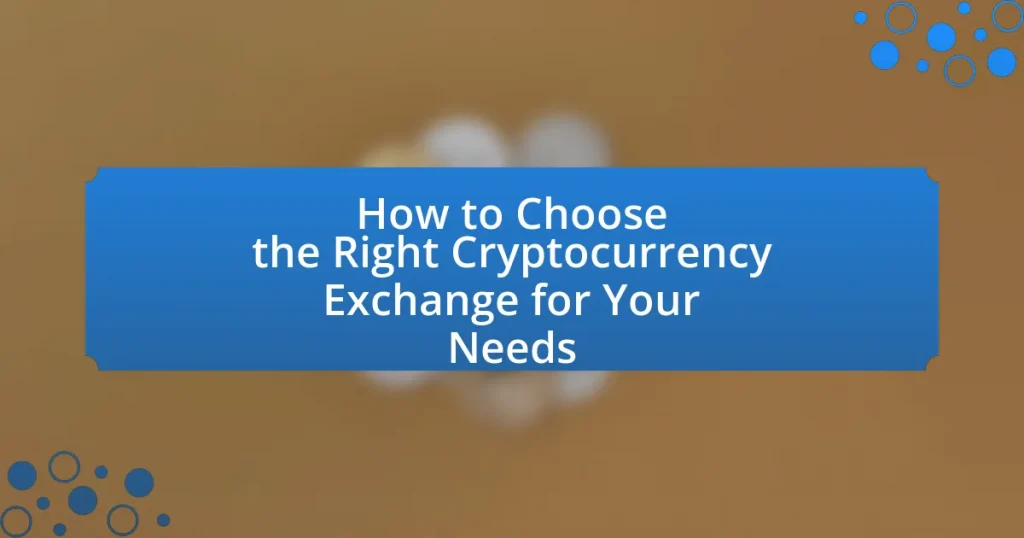Choosing the right cryptocurrency exchange is essential for effective trading and investment. Key factors to consider include security measures, fee structures, the variety of available cryptocurrencies, user experience, and regulatory compliance. The article explores the differences between centralized and decentralized exchanges, the advantages of peer-to-peer platforms, and the importance of liquidity and payment methods. Additionally, it provides best practices for evaluating exchanges, conducting thorough research, and avoiding common pitfalls, ensuring users can make informed decisions tailored to their trading needs.

What Should You Consider When Choosing a Cryptocurrency Exchange?
When choosing a cryptocurrency exchange, consider factors such as security, fees, available cryptocurrencies, user experience, and regulatory compliance. Security is paramount; exchanges should employ robust measures like two-factor authentication and cold storage for funds. Fees can vary significantly, impacting your overall trading costs; thus, it’s essential to review both trading and withdrawal fees. The variety of cryptocurrencies offered is crucial for traders looking to diversify their portfolios, as some exchanges support a broader range than others. User experience, including the interface and customer support, affects how easily you can navigate the platform. Lastly, regulatory compliance ensures that the exchange operates within legal frameworks, providing a level of trust and safety for users.
How do different types of exchanges impact your trading experience?
Different types of exchanges significantly impact your trading experience by influencing factors such as liquidity, fees, and available trading pairs. Centralized exchanges typically offer higher liquidity and faster transaction speeds, which can enhance trading efficiency. For instance, Binance, a leading centralized exchange, provides access to a wide range of cryptocurrencies and trading pairs, allowing for diverse trading strategies. In contrast, decentralized exchanges prioritize user control and privacy but may have lower liquidity and slower transaction times, as seen with platforms like Uniswap. Additionally, fee structures vary; centralized exchanges often charge trading fees, while decentralized exchanges may have lower fees but require users to pay gas fees for transactions on the blockchain. These differences can affect overall trading costs and the ease of executing trades, ultimately shaping the trader’s experience.
What are the differences between centralized and decentralized exchanges?
Centralized exchanges (CEXs) operate under a single organization that facilitates trading by acting as an intermediary, while decentralized exchanges (DEXs) allow peer-to-peer trading without a central authority. CEXs typically offer higher liquidity and faster transaction speeds due to their centralized nature, making them user-friendly for beginners. In contrast, DEXs provide greater privacy and control over funds, as users retain ownership of their assets and trade directly from their wallets. According to a report by CoinMarketCap, as of 2023, CEXs account for approximately 70% of the total trading volume in the cryptocurrency market, highlighting their dominance and popularity among traders.
How do peer-to-peer exchanges work and what are their advantages?
Peer-to-peer (P2P) exchanges facilitate direct transactions between users without intermediaries. In these platforms, buyers and sellers connect to negotiate terms, such as price and payment method, often using an escrow service to ensure security during the transaction. This model allows for greater privacy and control over trades, as users can choose their counterparties and payment methods.
The advantages of P2P exchanges include lower fees compared to traditional exchanges, as they typically charge minimal transaction fees. Additionally, they provide access to a wider range of payment options, including cash, bank transfers, and digital wallets, accommodating users in regions with limited banking infrastructure. P2P exchanges also enhance user autonomy, allowing individuals to trade directly without relying on centralized authorities, which can be particularly beneficial in countries with restrictive financial regulations.
What factors influence the security of a cryptocurrency exchange?
The security of a cryptocurrency exchange is influenced by several key factors, including regulatory compliance, security protocols, and the exchange’s history of breaches. Regulatory compliance ensures that the exchange adheres to legal standards, which can enhance trust and security. Security protocols, such as two-factor authentication, cold storage of assets, and encryption, protect user funds and data from unauthorized access. Additionally, an exchange’s history of security incidents can indicate its reliability; for instance, exchanges with a track record of frequent hacks may pose a higher risk to users. These factors collectively determine the overall security posture of a cryptocurrency exchange.
How can you assess the security measures of an exchange?
To assess the security measures of an exchange, review its security protocols, including two-factor authentication (2FA), cold storage for funds, and regular security audits. Exchanges that implement 2FA significantly reduce the risk of unauthorized access, as it requires a second form of verification beyond just a password. Cold storage, which keeps the majority of funds offline, protects assets from online threats; for instance, exchanges like Coinbase and Binance utilize cold storage to safeguard user funds. Additionally, regular security audits by third-party firms can validate the effectiveness of an exchange’s security measures, as seen with exchanges that publish audit reports to demonstrate compliance with industry standards.
What role does regulatory compliance play in exchange security?
Regulatory compliance is crucial for exchange security as it establishes a framework of standards and practices that exchanges must follow to protect user assets and data. Compliance with regulations such as the Anti-Money Laundering (AML) and Know Your Customer (KYC) laws helps prevent fraud, money laundering, and other illicit activities, thereby enhancing the overall security of the exchange. For instance, exchanges that adhere to these regulations are often subject to regular audits and monitoring, which further mitigates risks associated with cyber threats and operational failures. This adherence not only builds trust among users but also ensures that the exchange operates within legal boundaries, reducing the likelihood of penalties or shutdowns by regulatory authorities.
What fees should you be aware of when selecting an exchange?
When selecting a cryptocurrency exchange, you should be aware of trading fees, withdrawal fees, deposit fees, and inactivity fees. Trading fees are typically charged as a percentage of the transaction amount and can vary between exchanges; for example, Binance charges a standard trading fee of 0.1%. Withdrawal fees are charged when you transfer your cryptocurrency to an external wallet, and these can vary based on the cryptocurrency being withdrawn; for instance, Bitcoin withdrawals may incur a fee of around 0.0005 BTC. Deposit fees may apply when funding your account, especially if using credit cards or certain payment methods, which can range from 0% to 5%. Inactivity fees may be charged if your account remains dormant for an extended period, with some exchanges imposing fees after six months of inactivity. Understanding these fees is crucial for evaluating the overall cost of using a particular exchange.
How do trading fees vary between exchanges?
Trading fees vary significantly between cryptocurrency exchanges, with some charging a flat fee per trade while others implement a tiered structure based on trading volume. For instance, major exchanges like Binance and Coinbase Pro typically charge fees ranging from 0.1% to 0.5% of the transaction amount, while decentralized exchanges may have different fee structures, often influenced by network congestion and liquidity. Additionally, some platforms offer fee discounts for users who hold their native tokens, such as Binance Coin, which can further affect the overall cost of trading. This variability in trading fees is crucial for users to consider when selecting an exchange, as it directly impacts profitability and trading strategy.
What are deposit and withdrawal fees, and how do they affect your choice?
Deposit and withdrawal fees are charges imposed by cryptocurrency exchanges for processing transactions involving the transfer of funds into and out of user accounts. These fees can significantly influence a user’s choice of exchange, as higher fees may deter users from frequent trading or transferring funds, ultimately affecting their overall trading strategy and profitability. For instance, if an exchange charges a 2% fee on deposits and withdrawals, a user transferring $1,000 would incur a $20 fee, which could be a substantial cost for active traders. Therefore, users often compare these fees across different exchanges to find the most cost-effective option that aligns with their trading habits and financial goals.

How Can You Evaluate the User Experience of a Cryptocurrency Exchange?
To evaluate the user experience of a cryptocurrency exchange, analyze key factors such as interface usability, transaction speed, customer support, and security features. A user-friendly interface allows for easy navigation and efficient trading, while transaction speed impacts the ability to execute trades promptly. Customer support responsiveness is crucial for resolving issues, and robust security measures protect user assets. According to a survey by Statista, 70% of users prioritize ease of use when selecting an exchange, highlighting the importance of these factors in user experience evaluation.
What features contribute to a user-friendly interface?
A user-friendly interface is characterized by features such as intuitive navigation, clear visual hierarchy, responsive design, and accessibility options. Intuitive navigation allows users to find information quickly, enhancing their overall experience. A clear visual hierarchy organizes content effectively, guiding users’ attention to important elements. Responsive design ensures that the interface adapts seamlessly across devices, maintaining usability on both desktop and mobile platforms. Accessibility options, such as screen reader compatibility and adjustable text sizes, make the interface usable for individuals with disabilities, broadening its reach. These features collectively contribute to a positive user experience, as evidenced by studies showing that well-designed interfaces can increase user satisfaction and engagement.
How important is mobile accessibility for trading on exchanges?
Mobile accessibility is crucial for trading on exchanges as it allows users to execute trades and manage their portfolios anytime and anywhere. The increasing reliance on smartphones for financial transactions highlights the necessity of mobile platforms; for instance, a study by Statista indicates that over 50% of online trading occurs via mobile devices. Furthermore, mobile accessibility enhances user engagement and responsiveness, enabling traders to capitalize on market opportunities in real-time, which is essential in the fast-paced cryptocurrency market.
What role does customer support play in user experience?
Customer support plays a critical role in user experience by providing assistance and resolving issues that users encounter while interacting with a service. Effective customer support enhances user satisfaction, fosters trust, and encourages user retention, particularly in the context of cryptocurrency exchanges where users may face complex transactions and security concerns. Research indicates that 70% of customers are willing to spend more with companies that provide excellent customer service, highlighting its importance in shaping positive user experiences.
How can you assess the liquidity of an exchange?
To assess the liquidity of an exchange, analyze its trading volume and order book depth. High trading volume indicates a greater number of transactions occurring, which typically correlates with better liquidity. For instance, exchanges like Binance and Coinbase often report daily trading volumes exceeding billions of dollars, demonstrating their liquidity. Additionally, examining the order book reveals the number of buy and sell orders at various price levels; a deeper order book with numerous orders at close price points suggests that large trades can be executed without significantly impacting the market price, further confirming liquidity.
What indicators can help you determine an exchange’s liquidity?
Indicators that can help determine an exchange’s liquidity include trading volume, order book depth, and bid-ask spread. Trading volume reflects the total amount of assets traded over a specific period, indicating how actively an exchange is used; higher volumes typically suggest better liquidity. Order book depth shows the number of buy and sell orders at various price levels, with a deeper order book indicating more liquidity as it can absorb larger trades without significant price changes. The bid-ask spread, which is the difference between the highest price a buyer is willing to pay and the lowest price a seller will accept, serves as a measure of liquidity; narrower spreads generally indicate higher liquidity, as they suggest that buyers and sellers can transact more easily.
Why is liquidity important for your trading strategy?
Liquidity is crucial for a trading strategy because it ensures that assets can be bought or sold quickly without significantly affecting their price. High liquidity allows traders to enter and exit positions efficiently, minimizing slippage and transaction costs. For instance, in highly liquid markets, such as Bitcoin, the average bid-ask spread is often less than 1%, which facilitates better pricing for trades. Conversely, low liquidity can lead to larger price fluctuations and increased costs, making it difficult to execute trades at desired prices. Therefore, a trading strategy that prioritizes liquidity can enhance profitability and reduce risk.
What are the available payment methods on different exchanges?
Different cryptocurrency exchanges offer various payment methods, including bank transfers, credit and debit cards, PayPal, and cryptocurrency deposits. For instance, Coinbase allows users to purchase cryptocurrencies using bank transfers and credit cards, while Binance supports bank transfers and credit card payments. Kraken accepts bank transfers and cryptocurrency deposits. These payment methods are essential for users to consider when selecting an exchange, as they impact the ease and speed of transactions.
How do payment options affect your ability to trade?
Payment options significantly influence your ability to trade by determining the speed, convenience, and cost of transactions. For instance, exchanges that offer multiple payment methods, such as credit cards, bank transfers, and digital wallets, enable traders to execute trades quickly and efficiently, enhancing liquidity. Conversely, limited payment options can lead to delays in funding accounts or withdrawing profits, which may hinder trading opportunities. According to a study by the Cambridge Centre for Alternative Finance, the availability of diverse payment methods is a critical factor for 70% of users when selecting a cryptocurrency exchange, highlighting the importance of payment flexibility in trading effectiveness.
What should you know about fiat-to-crypto conversion on exchanges?
Fiat-to-crypto conversion on exchanges involves the process of exchanging traditional currency, such as USD or EUR, for cryptocurrencies like Bitcoin or Ethereum. Users should be aware that different exchanges have varying fees, exchange rates, and supported fiat currencies, which can significantly impact the overall cost of the transaction. For instance, some exchanges may charge a flat fee, while others may take a percentage of the transaction amount. Additionally, the liquidity of the exchange can affect the speed and efficiency of the conversion process. According to a report by CoinMarketCap, as of 2023, the average fee for fiat-to-crypto transactions ranges from 0.1% to 5%, depending on the platform and payment method used. Understanding these factors is crucial for selecting the right exchange that meets individual needs and minimizes costs.

What Are the Best Practices for Choosing the Right Cryptocurrency Exchange?
To choose the right cryptocurrency exchange, prioritize security, user experience, fees, and available cryptocurrencies. Security is paramount; select exchanges with strong security measures, such as two-factor authentication and cold storage for assets. User experience matters; a user-friendly interface can simplify trading. Fees vary significantly; compare trading fees, withdrawal fees, and deposit fees across exchanges to find the most cost-effective option. Additionally, ensure the exchange supports a wide range of cryptocurrencies to meet your trading needs. According to a 2021 report by Chainalysis, exchanges with robust security protocols experience significantly fewer hacks, reinforcing the importance of security in your choice.
How can you conduct thorough research on exchanges?
To conduct thorough research on exchanges, start by evaluating their security features, such as two-factor authentication and cold storage for funds. Security is critical, as data breaches can lead to significant financial losses; for instance, the Mt. Gox hack in 2014 resulted in the loss of 850,000 Bitcoins, highlighting the importance of robust security measures.
Next, analyze the fees associated with trading, deposits, and withdrawals, as these can vary significantly between exchanges. For example, Binance charges a trading fee of 0.1%, while Coinbase can charge up to 1.5% for transactions, impacting overall profitability.
Additionally, review the range of cryptocurrencies offered, as some exchanges provide access to a wider variety of altcoins than others. For instance, Kraken supports over 50 cryptocurrencies, while some smaller exchanges may only offer a handful.
User reviews and ratings on platforms like Trustpilot or Reddit can provide insights into the user experience and customer support quality. A high rating on Trustpilot, for example, can indicate a reliable exchange.
Lastly, check for regulatory compliance and licensing in your jurisdiction, as this ensures that the exchange operates within legal frameworks, reducing the risk of fraud. For instance, exchanges like Gemini and Coinbase are regulated in the United States, providing an added layer of trust for users.
What resources are available for comparing cryptocurrency exchanges?
Several resources are available for comparing cryptocurrency exchanges, including websites like CoinMarketCap, CoinGecko, and CryptoCompare. These platforms provide comprehensive data on exchange features, trading volumes, fees, and user reviews, allowing users to evaluate and contrast different exchanges effectively. For instance, CoinMarketCap lists over 400 exchanges and offers metrics such as liquidity and security ratings, which are crucial for informed decision-making. Additionally, user forums and social media platforms can provide real-time feedback and experiences from other traders, further aiding in the comparison process.
How can user reviews and ratings inform your decision?
User reviews and ratings can significantly inform your decision by providing insights into the experiences of other users with a cryptocurrency exchange. These reviews often highlight key aspects such as the platform’s reliability, customer service quality, and transaction fees. For instance, a study by the Pew Research Center found that 82% of consumers read online reviews before making a purchase, indicating the importance of peer feedback in decision-making. Additionally, high ratings can signal trustworthiness and user satisfaction, while negative reviews may reveal potential issues or risks associated with a particular exchange. Therefore, analyzing user feedback can help you make a more informed choice that aligns with your specific needs in selecting a cryptocurrency exchange.
What common pitfalls should you avoid when selecting an exchange?
When selecting a cryptocurrency exchange, avoid pitfalls such as inadequate security measures, lack of regulatory compliance, and poor user reviews. Inadequate security can lead to hacks and loss of funds; for instance, exchanges like Mt. Gox suffered significant breaches, resulting in the loss of millions. Lack of regulatory compliance can expose users to legal risks, as unregulated exchanges may not protect consumer rights. Additionally, poor user reviews often indicate issues with customer service or platform reliability, which can hinder trading experiences. Therefore, thorough research on security protocols, regulatory status, and user feedback is essential to mitigate these risks.
How can you identify scams or unreliable exchanges?
To identify scams or unreliable exchanges, research the exchange’s regulatory compliance and user reviews. Reliable exchanges are typically registered with financial authorities and have transparent operational practices. For instance, exchanges like Coinbase and Binance are regulated in multiple jurisdictions, which adds a layer of trust. Additionally, checking user reviews on platforms like Trustpilot or Reddit can reveal red flags such as poor customer service or withdrawal issues, which are common indicators of unreliable exchanges.
What red flags should you look for in exchange policies?
Red flags to look for in exchange policies include unclear terms of service, high fees, lack of transparency regarding security measures, and limited customer support options. Unclear terms can lead to unexpected charges or restrictions, while high fees can significantly impact trading profitability. A lack of transparency about security measures raises concerns about the safety of funds, as exchanges should clearly outline their protocols for protecting user assets. Additionally, limited customer support can indicate poor service quality, making it difficult for users to resolve issues. These factors collectively suggest potential risks associated with using the exchange.
What tips can help you make an informed choice?
To make an informed choice when selecting a cryptocurrency exchange, prioritize researching the exchange’s reputation and security features. A reputable exchange typically has a history of reliability and positive user reviews, while robust security measures, such as two-factor authentication and cold storage for funds, help protect your assets. According to a 2021 report by Chainalysis, exchanges with higher security ratings experience significantly fewer hacks, underscoring the importance of choosing a secure platform. Additionally, compare fees, available cryptocurrencies, and user experience across different exchanges to ensure the platform aligns with your trading needs and preferences.
How can you start with a small investment to test an exchange?
To start with a small investment to test an exchange, you can deposit a minimal amount, typically as low as $10 or $20, depending on the exchange’s minimum deposit requirements. Many exchanges allow users to create accounts with minimal verification, enabling them to trade small amounts of cryptocurrency. For example, platforms like Coinbase and Binance have low entry thresholds, making them accessible for testing. This approach allows you to evaluate the exchange’s user interface, transaction speed, and customer support without significant financial risk.
What should you do if you encounter issues with an exchange?
If you encounter issues with an exchange, you should first contact the exchange’s customer support for assistance. Most reputable exchanges provide multiple channels for support, including email, live chat, and phone support, allowing users to report problems directly. Additionally, reviewing the exchange’s help center or FAQ section can provide immediate solutions to common issues. According to a survey by the Blockchain Research Institute, 70% of users reported that prompt customer service significantly influenced their satisfaction with an exchange.


